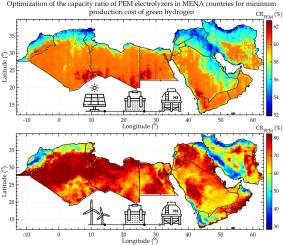可再生氢地平线:中东和北非地理空间技术经济可行性和生命周期温室气体分析
IF 8.3
2区 工程技术
Q1 CHEMISTRY, PHYSICAL
引用次数: 0
摘要
可再生氢因其在运输和工业等部门作为灵活能源载体的潜力而受到越来越多的关注。由于可再生能源资源和供应链动态的差异,可再生氢生产的具体成本和碳强度(CI)在很大程度上取决于地点。本研究利用丰富的太阳能和风能资源,绘制了中东和北非地区可再生制氢的技术经济和生命周期温室气体排放图。这项工作研究了氢成本和CI的变化,优化质子交换膜(PEM)电解槽的尺寸,以考虑部分和循环负荷,并探索了独立与并网系统。光伏(PV)系统的PEM容量比为52% - 63%,风能系统的PEM容量比为28% - 82%,这是最优的,光伏系统的氢气生产成本为3.8- 4.8美元/公斤,风能系统的氢气生产成本为2.0- 7.0美元/公斤。光伏系统的ci范围为1.9 - 3.7 kg CO2,eq/kg H2,风力系统为0.4-7.7 kg CO2,eq/kg H2。该研究强调,通过技术进步以及氧气和多余电力销售的副产品收入,可以显著降低成本和CI。本文章由计算机程序翻译,如有差异,请以英文原文为准。

Renewable hydrogen horizon: Geospatial techno-economic feasibility and life cycle greenhouse gas analysis in the Middle East and North Africa
Renewable hydrogen is receiving increasing attention for its potential as a flexible energy carrier in sectors such as transportation and industry. Specific cost and carbon intensity (CI) of renewable hydrogen production vary largely based on the location, owing to differences in renewable energy resources, as well as the supply chain dynamics. This study maps the techno-economic and life cycle greenhouse gas emissions of renewable hydrogen production in the Middle East and North Africa region, leveraging abundant solar and wind resources. The work investigates the variability in hydrogen costs and CI, optimally sizing proton-exchange membrane (PEM) electrolyzers to account for partial and cyclic loading, and explores standalone versus grid-connected systems. PEM capacity ratios of 52 %–63 % for photovoltaic (PV) systems and 28 %–82 % for wind systems were identified as optimal, with hydrogen production costs ranging from $3.8-$4.8/kg for PV and $2.0-$7.0/kg for wind. CIs span from 1.9 to 3.7 kg CO2,eq/kg H2 for PV and 0.4–7.7 kg CO2,eq/kg H2 for wind systems. The study highlights significant cost and CI reductions achievable with technological advancements and co-product revenue from oxygen and excess electricity sales.
求助全文
通过发布文献求助,成功后即可免费获取论文全文。
去求助
来源期刊

International Journal of Hydrogen Energy
工程技术-环境科学
CiteScore
13.50
自引率
25.00%
发文量
3502
审稿时长
60 days
期刊介绍:
The objective of the International Journal of Hydrogen Energy is to facilitate the exchange of new ideas, technological advancements, and research findings in the field of Hydrogen Energy among scientists and engineers worldwide. This journal showcases original research, both analytical and experimental, covering various aspects of Hydrogen Energy. These include production, storage, transmission, utilization, enabling technologies, environmental impact, economic considerations, and global perspectives on hydrogen and its carriers such as NH3, CH4, alcohols, etc.
The utilization aspect encompasses various methods such as thermochemical (combustion), photochemical, electrochemical (fuel cells), and nuclear conversion of hydrogen, hydrogen isotopes, and hydrogen carriers into thermal, mechanical, and electrical energies. The applications of these energies can be found in transportation (including aerospace), industrial, commercial, and residential sectors.
 求助内容:
求助内容: 应助结果提醒方式:
应助结果提醒方式:


